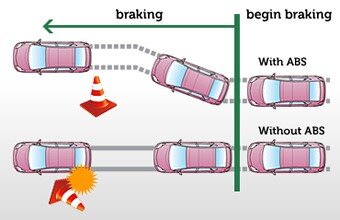ABS is simple to use
ABS or Anti-lock Braking Systems’ have become commonplace in the U.S. but not everyone knows their advantages or even how to use them properly. The anti-lock braking system, now present in all modern U.S. cars 2012 models and newer, prevents the wheels from locking up and helps the tires maintain grip with the road surface.
An anti-lock braking system is very simple to use. If your goal is to stop in the shortest distance possible, hit the brake with as much force as you can. When you slam on the brakes you'll hear an obnoxious grinding noise and feel the pedal will pulsate back and forth under your foot, but that's ok. That feedback is your ABS working correctly.
How does it work?
ABS is part of an overall stability system, commonly known as electronic stability control, which monitors wheel speed and other factors. Each wheel on your vehicle has a sensor attached to it. If the sensors detect that a wheel is about to lock up and stop moving, the system will release some of the brake’s pressure. The release is only for a moment. ABS then continuously and repeatedly applies optimum braking pressure to each wheel, allowing the system to brake as much as possible without locking up the wheels.
When ABS is active you may feel pulsations through the brake pedal as you’re pushing it. These can feel like minor vibrations or large pulsations in which the pedal goes almost through its full motion. You will also likely hear various mechanical noises (like grinding sounds). This feedback you hear and feel while the ABS is active is normal and should be almost viewed as “comforting” In a dangerous situation in which you need your ABS, because the commotion lets you know it’s working properly.
Biggest Advantages
The anti-lock braking system prioritizes keeping the driver in control of the vehicle rather than bringing the car to its shortest possible stopping distance. ABS helps the driver continue to steer the vehicle by keeping the wheels from locking up. While it’s possible to avoid wheel lockup by adjusting the pressure you put on the brake pedal in a non-ABS car, that method, threshold braking, is much more complicated and requires some level of skill.
It is a common misconception that ABS helps reduce stopping distance. When used properly ABS does provide you with a fairly short stopping distance overall, it just isn’t the biggest reason we should all have it. Its biggest advantage is that it keeps the wheels turning until the car is stopped, which allows you as the driver to stay in control of the vehicle and maintain your steering ability if needed. ABS is very simple to use and takes a lot of the skill out of avoiding a potentially deadly crash.
Other Advantages
Ease of use: hit the brake as hard as possible if your goal is to stop or slow down quickly.
Cars fitted with ABS are less likely to be involved in a fatal crash.
ABS decreases the chance of frontal collision on wet and dry roads.
Cars with ABS rarely stray from the road surface.





